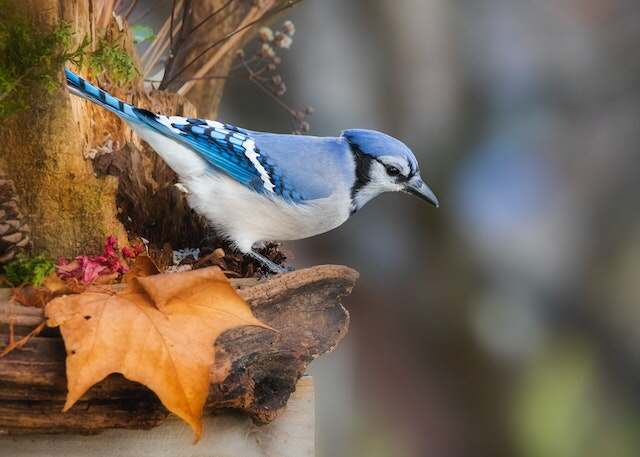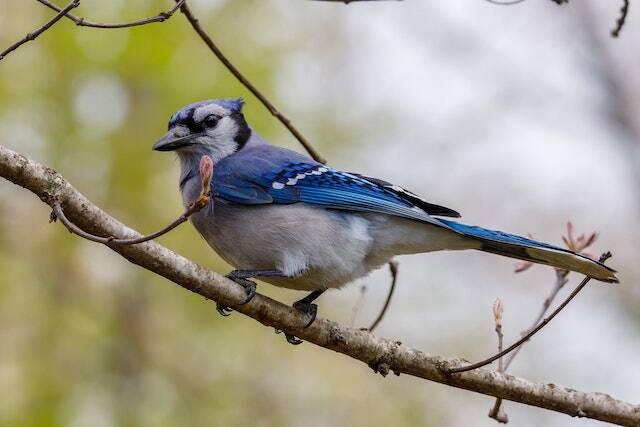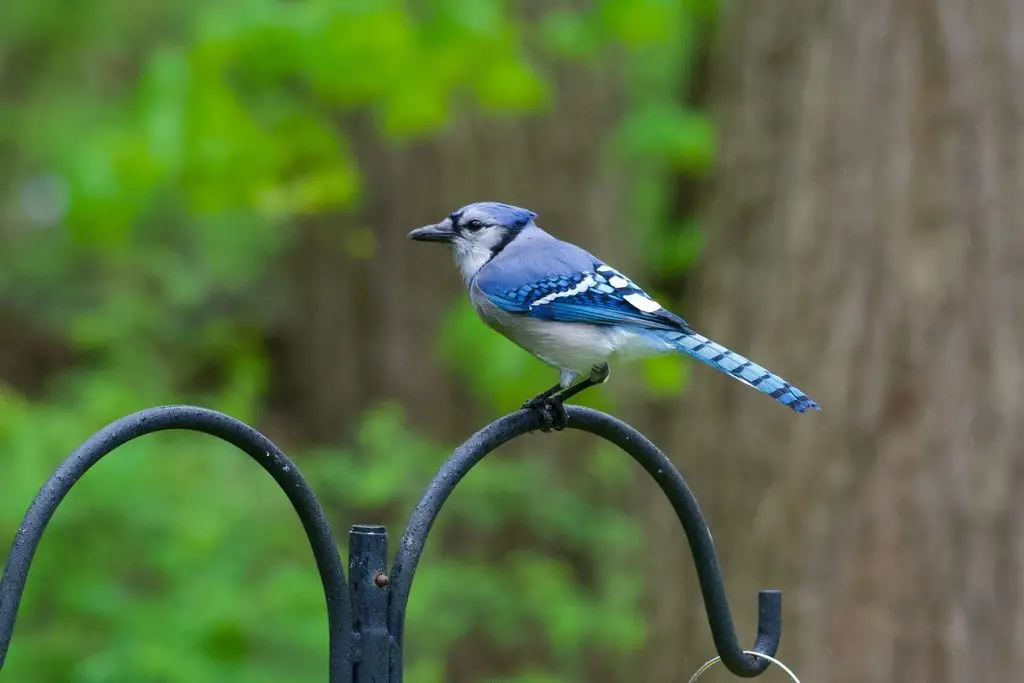Have you ever watched the blue jays outside your window and wondered if they fly away during certain times of the year? Today, we’re diving into that question: do blue jays migrate? Join us as we take a closer look at these beautiful birds, their habits, and whether they take long journeys like some other birds do.
Table of Contents
- 1 Key Takeaways
- 2 Do Blue Jays Migrate
- 3 Understanding Bird Migration
- 4 The Migration Patterns of North American Birds
- 5 The Behavior of Blue Jays
- 6 Factors Influencing Migration
- 7 Blue Jay Populations and Migration Routes
- 8 Climate and Seasonal Changes
- 9 The Role of Instinct and Genetics
- 10 Observing Blue Jay Migration
- 11 Conservation Efforts for Migratory Birds
- 12 The Future of Blue Jay Migration
- 13 Frequently Asked Questions
- 13.1 How long do blue jays typically stay in one location during migration?
- 13.2 Are there any specific landmarks or geographical features that blue jays use as navigation points during migration?
- 13.3 Do blue jays migrate in groups or do they travel alone?
- 13.4 Are there any specific threats or predators that blue jays face during their migration?
- 13.5 Are there any known instances of blue jays changing their migration patterns in response to human activities or habitat changes?
- 14 Conclusion
- 15 Author
Key Takeaways
- Blue jays exhibit migratory behavior influenced by various factors including breeding opportunities, distance of migration, wintering grounds, habitat loss, and winter survival adaptations.
- Blue jays migrate to areas with milder climates and abundant food resources in winter, while some remain in their breeding grounds throughout the year.
- Blue jays possess a genetic predisposition to migrate and rely on instinct to follow similar routes year after year.
- Climate change, habitat loss, and fragmentation can impact blue jay migration patterns and the availability of suitable stopover sites.

Do Blue Jays Migrate
Yes, Blue Jays do migrate. Like many other bird species, Blue Jays embark on long journeys in response to changes in temperature, food availability, and daylight hours.
They seek more favorable conditions for breeding, feeding, and survival.
These vibrant blue birds are known for their migratory behavior, captivating the minds of scientists and nature enthusiasts alike.
Understanding Bird Migration
The phenomenon of bird migration, a captivating natural occurrence that has fascinated scientists and naturalists alike, is crucial in understanding the behavior and movement patterns of Blue Jays.
Blue jay migration is a complex process influenced by various factors, including geographical location, climate and temperature, and food availability.
Blue Jays are known to be partially migratory, meaning that some populations migrate while others remain in their breeding grounds throughout the year.
The decision to migrate is often driven by the availability of food resources, as Blue Jays rely heavily on acorns and other nuts for sustenance.
As winter approaches and food becomes scarce, Blue Jays from northern regions migrate southward in search of better foraging opportunities.
This migratory behavior allows them to take advantage of milder climates and abundant food sources in their wintering grounds.
However, not all Blue Jays migrate, as individuals in more southern regions may have access to year-round food resources and favorable climates.
Understanding the migration patterns of North American birds, including Blue Jays, provides valuable insights into their ecological needs and the conservation efforts required to ensure their survival.
The Migration Patterns of North American Birds
One characteristic of North American birds is their migration patterns, which involve seasonal movements and long-distance journeys.
The timing of migration varies among different species, but generally, many birds from the eastern United States, including the Gulf coast, Mexico, and the Caribbean islands, migrate to warmer regions during the winter months.
This migration allows them to find more favorable conditions for feeding and to escape the harsh winter weather. These journeys can span thousands of miles, with some birds traveling as far as South America.
The migration patterns of North American birds are fascinating and complex, involving a combination of genetic programming and environmental cues.
Understanding these patterns provides valuable insight into the behavior of birds and their ability to adapt to changing conditions.
In the subsequent section, we will explore the behavior of blue jays, another migratory bird species, to further understand the intricacies of bird migration.
The Behavior of Blue Jays
An examination of the behavior of blue jays reveals a complex interplay between genetic programming and environmental cues, shedding light on the intricacies of their migratory journeys.
Blue jays exhibit significant behavioral changes during migration, including alterations in foraging activity and roosting behavior.
As they prepare for migration, blue jays increase their foraging activity, consuming large amounts of food to build up energy reserves for their long journeys.
They also modify their roosting behavior, often forming large flocks at night for safety and warmth.
Navigation and orientation are critical skills for blue jays during migration, and they rely on a combination of genetic programming and environmental cues to find their way.
While they have an innate ability to sense the Earth’s magnetic field, blue jays also use landmarks, celestial cues, and visual cues from the landscape to navigate.
However, their migratory journeys are not without challenges. Blue jays face the risk of predation during migration, as they become more vulnerable to predators due to their increased visibility in open areas.
This risk influences their behavior, as they tend to fly in larger groups for protection during migration.
In conclusion, the behavior of blue jays during migration is a fascinating topic that highlights the delicate balance between genetic programming and environmental factors.
Understanding these behavioral patterns provides valuable insights into the factors influencing migration in blue jays and other migratory birds.

Factors Influencing Migration
Factors influencing migration in blue jays and other migratory birds encompass a multitude of genetic and environmental variables.
When it comes to blue jays specifically, one key factor is the availability of breeding opportunities. Blue jays tend to migrate to regions where they can find suitable mates and establish territories for breeding.
Additionally, the distance of migration plays a role in their decision to migrate.
Blue jays typically migrate shorter distances compared to other migratory birds, as they can tolerate colder temperatures and find sufficient food sources along the way.
However, the wintering grounds also play a crucial role in their migration patterns. Blue jays migrate to areas with milder climates and abundant food resources during the winter months.
Another significant factor is the impact of habitat loss and fragmentation.
As human activities continue to alter landscapes, the availability of suitable habitats for blue jays and other migratory birds diminishes, affecting their migration patterns.
Finally, winter survival adaptations influence the migration behavior of blue jays.
These birds have developed physiological and behavioral adaptations to survive harsh winter conditions, such as storing food and growing thicker plumage.
These adaptations influence their decision to migrate or stay in their current location.
In summary, factors such as breeding opportunities, distance of migration, wintering grounds, habitat loss and fragmentation, and winter survival adaptations all contribute to the complex migration patterns of blue jays.
Understanding these influences can provide valuable insights into the conservation and management of their populations.
Transitioning into the subsequent section about blue jay populations and migration routes, it is important to analyze how these factors shape the specific paths taken by these birds.
Blue Jay Populations and Migration Routes
Blue jay populations and migration routes can be influenced by a variety of factors, including breeding opportunities, distance of migration, wintering grounds, habitat loss and fragmentation, and winter survival adaptations.
Migration is a crucial behavior for blue jays, as it allows them to find suitable breeding and wintering locations.
Blue jay populations may fluctuate based on the availability of resources and breeding opportunities in a particular area.
The distance of migration also plays a role, as blue jays may choose different routes based on factors such as weather patterns and the availability of suitable stopover sites.
Wintering grounds are another important consideration, as blue jays require locations with sufficient food resources and shelter.
Habitat loss and fragmentation can disrupt migration routes and limit the availability of suitable breeding and wintering locations for blue jays.
Additionally, blue jays have adapted to survive harsh winter conditions through behaviors such as caching food and growing additional feathers for insulation.
Understanding these factors is crucial for conservation efforts to ensure the long-term survival of blue jay populations and their migration routes.
As we transition into the subsequent section about climate and seasonal changes, it is important to note that these factors can also influence blue jay migration and their ability to adapt to changing environmental conditions.
Climate and Seasonal Changes
Climate and seasonal changes play a significant role in shaping the migratory patterns and adaptations of blue jays.
1) Physiological changes: Blue jays experience physiological changes in response to seasonal shifts, such as increased fat storage and hormonal adjustments, which prepare them for long-distance migration.
2) Weather conditions: Blue jays rely on favorable weather conditions, such as mild winds and clear skies, to undertake their migratory journeys. Unfavorable weather, such as strong winds or storms, can hinder their migration or even cause them to change course.
3) Protecting migration: Blue jays travel in flocks during migration, which offers them protection from predators and helps them navigate through unfamiliar territories. The collective behavior of flocks allows for better communication and coordination, making their journey safer.
4) Winter diet: The availability of food resources also influences blue jays’ migratory patterns. As winter approaches and food becomes scarce in their breeding grounds, blue jays migrate to regions where there is a more abundant winter food supply. This helps them survive during the colder months.
Transitioning to the subsequent section, the role of instinct and genetics also plays a crucial part in blue jays’ migration strategies.

The Role of Instinct and Genetics
Instinct and genetic factors heavily influence the migratory behaviors of blue jays. These birds have evolved over time to possess a strong instinctual drive to migrate in order to survive and reproduce.
Genetic factors play a role in determining the timing, duration, and distance of their migrations.
Blue jays possess a genetic predisposition to migrate, and this behavior is passed down from one generation to the next.
The ability to migrate allows blue jays to adapt to changing environmental conditions and avoid potential extinction risks.
During winter, when food sources become scarce and temperatures drop, blue jays rely on their migratory instincts to find more favorable habitats.
Additionally, the coloration of blue jays during winter serves as camouflage, helping them blend in with their surroundings and protect themselves from predators.
Understanding the role of instinct and genetics in blue jay migration is essential for conservation efforts and ensuring the long-term survival of these remarkable birds.
Transitioning into the subsequent section about observing blue jay migration, it is important to study their behavior in order to gain further insights into their fascinating migratory patterns.
Observing Blue Jay Migration
The role of instinct and genetics in blue jay migration is a fascinating area of study. However, in order to truly understand their migratory patterns, it is essential to observe blue jay migration in action.
Researchers have been conducting extensive field studies to track the movement of blue jays across different regions and seasons.
By using techniques such as banding and satellite tracking, scientists have been able to gather valuable data on the routes taken by blue jays during migration, as well as the timing and duration of their journeys.
These observations have revealed interesting patterns, such as the tendency of blue jays to follow similar routes year after year, suggesting a strong reliance on instinct and genetic programming.
Additionally, the observations have shed light on the environmental factors that influence blue jay migration, such as weather conditions and food availability.
By understanding these patterns and factors, scientists can better inform conservation efforts for migratory birds.
Transitioning into the subsequent section about conservation efforts for migratory birds, it is crucial to recognize the importance of preserving habitats and providing safe stopover sites along migration routes to ensure the survival and well-being of blue jays and other migratory species.
Conservation Efforts for Migratory Birds
One of the key aspects of preserving migratory bird populations is the establishment of protected habitats and secure rest areas along their migration routes, ensuring their survival and well-being.
These conservation efforts play a crucial role in safeguarding the future of migratory birds, including blue jays.
By creating protected areas, such as national parks or wildlife refuges, birds are provided with safe places to rest and refuel during their long journeys.
Additionally, conservation organizations and governments work together to implement measures that reduce threats to migratory birds, such as habitat loss, pollution, and climate change.
These efforts are supported by scientific research and monitoring programs that help identify critical habitats and inform conservation strategies.
To further engage the public and raise awareness about the importance of migratory bird conservation, education and outreach initiatives are also implemented.
Overall, these conservation efforts are essential in ensuring the survival of migratory birds and maintaining their populations.
Looking ahead, understanding the future of blue jay migration will require ongoing research and collaboration to address the challenges posed by climate change and other factors that may impact their migratory patterns.

The Future of Blue Jay Migration
Migration patterns of blue jays may undergo significant shifts in response to changing environmental conditions, highlighting the need for continued research and conservation efforts.
As climate change continues to impact ecosystems around the world, it is crucial to understand how these changes will affect the migratory behavior of blue jays.
Studies have shown that temperature, precipitation, and food availability can all influence migration patterns in birds.
For blue jays, which are known for their long-distance migrations, alterations in these environmental factors can have profound effects on their ability to successfully navigate their annual journeys.
Furthermore, habitat loss and fragmentation can also impact the availability of suitable stopover sites, where blue jays rest and refuel during their migrations.
These factors combined raise concerns about the future of blue jay migration and the potential consequences for their populations.
To address these concerns, ongoing research is needed to track blue jay populations, monitor their migratory routes, and identify key stopover sites.
Conservation efforts should focus on preserving and restoring habitats that are crucial for blue jay migration, as well as implementing measures to mitigate the impacts of climate change.
By understanding and protecting the factors that drive blue jay migration, we can help ensure the long-term survival and freedom of these remarkable birds.
Frequently Asked Questions
How long do blue jays typically stay in one location during migration?
During migration, blue jays typically stay in one location for a variable duration, which depends on factors such as food availability and weather conditions. This period can range from a few days to several weeks or even months.
Blue jays use a combination of visual cues, magnetic fields, and celestial navigation to navigate during migration. They may also rely on familiar geographical features such as mountains, rivers, and coastlines as landmarks for orientation and navigation.
Do blue jays migrate in groups or do they travel alone?
Blue jays generally migrate in loose flocks, but they may also travel alone. The choice to migrate in groups or alone may depend on factors such as food availability, weather conditions, and individual behavior.
Are there any specific threats or predators that blue jays face during their migration?
During their migration, blue jays face various threats and predators. These include birds of prey such as hawks and owls, as well as mammals like squirrels and cats, seeking to prey upon them.
Are there any known instances of blue jays changing their migration patterns in response to human activities or habitat changes?
Instances of blue jays altering their migration patterns in response to human activities or habitat changes have been documented. These changes may occur due to alterations in food availability, climate, or the presence of anthropogenic disturbances in their traditional migratory routes.

Conclusion
In conclusion, blue jays are known to be migratory birds, exhibiting a complex and fascinating behavior that has been studied for many years.
Their migration patterns are influenced by various factors, including seasonal changes, food availability, and genetics.
Blue jays are known to migrate in flocks, following established routes that have been shaped by their instinct and genetic predisposition.
One interesting statistic that highlights the remarkable nature of blue jay migration is their ability to cover long distances during their journeys.
Research has shown that blue jays can travel up to 2,500 kilometers (1,550 miles) during their migration, which is quite impressive considering their small size and relatively short wingspan.
This statistic paints a vivid picture of the determination and resilience of these birds as they navigate vast distances in search of suitable habitats and resources.
Understanding the behavior and migration patterns of blue jays is crucial for their conservation.
Efforts have been made to protect and preserve their habitats along their migration routes, as well as raising awareness about the importance of maintaining biodiversity and promoting sustainable practices.
By studying and observing blue jay migration, scientists can continue to unravel the mysteries of this remarkable phenomenon and contribute to the overall understanding of bird migration as a whole.
In the future, continued research and conservation efforts will be essential in ensuring the survival and well-being of blue jays and other migratory bird species.
By understanding the factors that influence their migration and protecting their habitats, we can help support these birds on their incredible journeys and ensure their presence in our ecosystems for generations to come.



